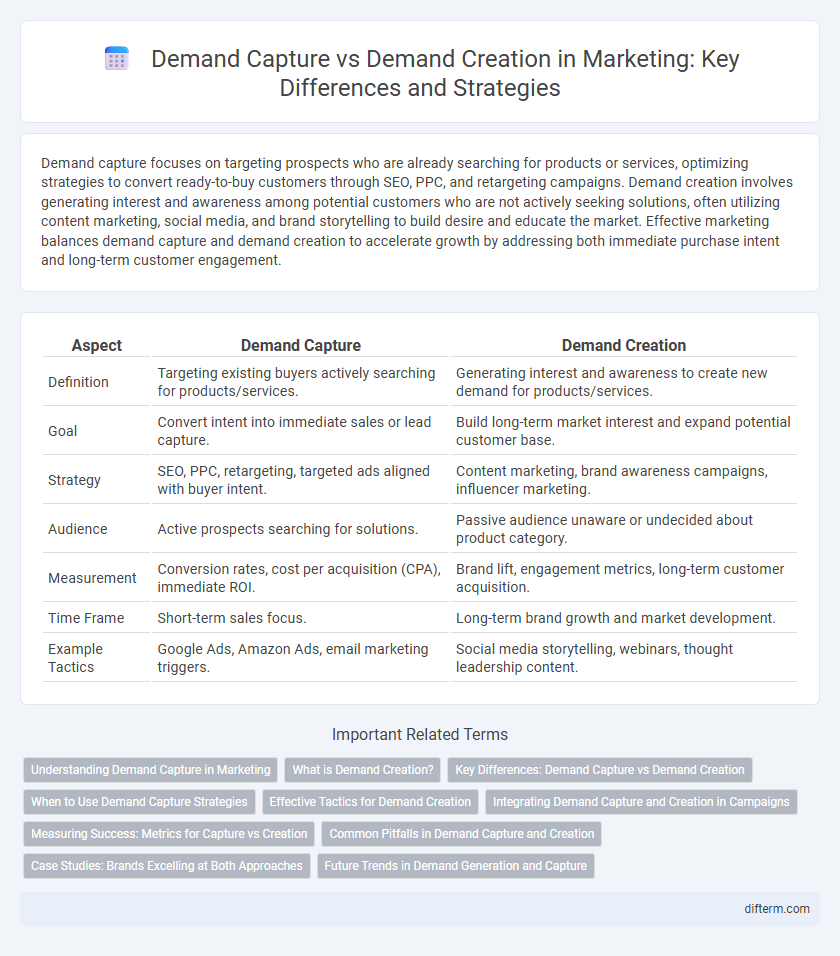Demand capture focuses on targeting prospects who are already searching for products or services, optimizing strategies to convert ready-to-buy customers through SEO, PPC, and retargeting campaigns. Demand creation involves generating interest and awareness among potential customers who are not actively seeking solutions, often utilizing content marketing, social media, and brand storytelling to build desire and educate the market. Effective marketing balances demand capture and demand creation to accelerate growth by addressing both immediate purchase intent and long-term customer engagement.
Table of Comparison
| Aspect | Demand Capture | Demand Creation |
|---|---|---|
| Definition | Targeting existing buyers actively searching for products/services. | Generating interest and awareness to create new demand for products/services. |
| Goal | Convert intent into immediate sales or lead capture. | Build long-term market interest and expand potential customer base. |
| Strategy | SEO, PPC, retargeting, targeted ads aligned with buyer intent. | Content marketing, brand awareness campaigns, influencer marketing. |
| Audience | Active prospects searching for solutions. | Passive audience unaware or undecided about product category. |
| Measurement | Conversion rates, cost per acquisition (CPA), immediate ROI. | Brand lift, engagement metrics, long-term customer acquisition. |
| Time Frame | Short-term sales focus. | Long-term brand growth and market development. |
| Example Tactics | Google Ads, Amazon Ads, email marketing triggers. | Social media storytelling, webinars, thought leadership content. |
Understanding Demand Capture in Marketing
Demand capture in marketing focuses on identifying and engaging customers actively searching for specific products or services, converting existing demand into sales. It leverages targeted strategies like search engine marketing (SEM), pay-per-click (PPC) advertising, and retargeting campaigns to optimize conversion rates. Understanding demand capture enables marketers to allocate budget efficiently, maximize return on investment (ROI), and drive immediate revenue growth by capitalizing on intent-driven consumer behavior.
What is Demand Creation?
Demand creation involves generating awareness and interest in a product or service among potential customers who may not yet recognize their need or desire for it. It leverages strategies like content marketing, influencer partnerships, and innovative advertising to spark new demand in untapped markets. By cultivating early-stage engagement, demand creation drives long-term growth and expands the customer base beyond existing market demand.
Key Differences: Demand Capture vs Demand Creation
Demand capture focuses on attracting and converting customers who are already searching for specific products or services, leveraging intent-driven strategies like search engine marketing and retargeting. Demand creation aims to generate interest and awareness among audiences unfamiliar with the brand or product through brand storytelling, content marketing, and educational campaigns. Key differences lie in targeting existing demand versus stimulating new demand, with demand capture delivering immediate ROI and demand creation building long-term brand equity.
When to Use Demand Capture Strategies
Demand capture strategies are most effective when targeting customers who are actively searching for specific products or services, allowing businesses to capitalize on existing purchase intent. These strategies optimize marketing efforts by focusing on high-intent keywords, retargeting ads, and content that aligns with immediate consumer needs. Companies should prioritize demand capture during peak buying seasons or product launch phases to maximize conversion rates and ROI.
Effective Tactics for Demand Creation
Effective tactics for demand creation in marketing focus on educating potential customers through valuable content, targeted advertising, and influencer partnerships that stimulate interest and awareness. Leveraging personalized campaigns and interactive experiences increases engagement and drives brand affinity, ultimately sparking new demand. Utilizing data-driven insights further refines messaging to attract untapped audiences and generate sustained market growth.
Integrating Demand Capture and Creation in Campaigns
Integrating demand capture and demand creation in marketing campaigns maximizes ROI by targeting consumers at all stages of the buying funnel. Demand capture focuses on converting existing interest through targeted ads and retargeting, while demand creation builds awareness and generates new interest via content marketing and influencer partnerships. Combining these strategies ensures a seamless customer journey that drives both immediate sales and long-term brand growth.
Measuring Success: Metrics for Capture vs Creation
Demand capture metrics focus on conversion rates, cost per acquisition (CPA), and return on ad spend (ROAS) to evaluate the effectiveness of targeting existing demand. Demand creation metrics emphasize brand awareness, engagement rates, and customer lifetime value (CLV) to assess the impact of generating new demand. Combining these metrics provides a comprehensive view of marketing performance and guides resource allocation between immediate sales and long-term growth.
Common Pitfalls in Demand Capture and Creation
Common pitfalls in demand capture include neglecting targeted audience segmentation and overreliance on short-term tactics that fail to nurture leads effectively. In demand creation, brands often struggle with vague messaging and lack of clear value propositions, leading to poor brand differentiation. Both strategies suffer when marketing teams fail to align goals with customer journey insights, resulting in wasted budget and missed growth opportunities.
Case Studies: Brands Excelling at Both Approaches
Case studies reveal that brands like Amazon and Nike excel in both demand capture and demand creation by leveraging data-driven targeting and innovative storytelling to engage consumers at every stage of the buying journey. Amazon's use of personalized recommendations and seamless e-commerce experience efficiently captures demand, while Nike's compelling campaigns and brand ethos create strong emotional connections that generate new market interest. These examples highlight the critical balance of using precise demand capture techniques alongside impactful demand creation strategies to maximize market share and drive growth.
Future Trends in Demand Generation and Capture
Future trends in demand generation emphasize leveraging AI-driven analytics and personalized content to enhance customer targeting and engagement, boosting demand capture efficiency. Advances in data integration enable seamless alignment between demand creation strategies and real-time market insights, optimizing campaign performance. The rise of omnichannel marketing and interactive digital experiences further transforms demand capture, offering brands innovative ways to convert interest into actionable demand.
Demand capture vs demand creation Infographic

 difterm.com
difterm.com